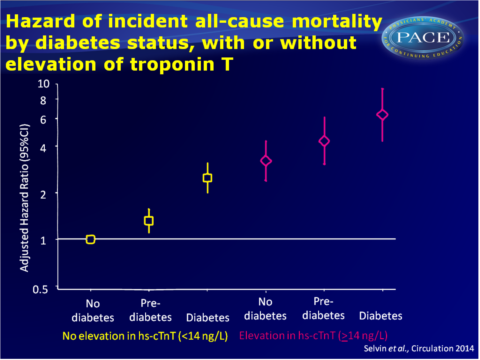Hyperglycaemia appears harmful to the myocardium, also in prediabetics
Both prediabetes and diabetes showed a higher incidence of subclinical myocardial damage, as assessed by hs-cTnT, associated with higher CV event risk.
Diabetes Mellitus, Prediabetes, and Incidence of Subclinical Myocardial DamageLiterature - Selvin E et al., Circulation. 2014
Selvin E, Lazo M, Chen Y, et al.
Circulation. 2014;130:1374-1382. doi: 10.1161/CIRCULATIONAHA.114.010815
Background
Evidence exists that at the time of clinical diagnosis of diabetes mellitus (DM), there is often already cardiac damage [1,2]. Also if people do not meet diagnostic criteria yet for DM, hyperglycaemia is thought to induce coronary microvascular dysfunction [3-8], resulting in myocardial injury and putting people at risk for cardiovascular events. Persons with prediabetes or DM have been shown to have an increased prevalence of atherosclerosis, as measured by carotid intimal thickness or coronary artery calcium [8-13].The relationship between prediabetes or DM and subclinical myocardial damage is less clear. A novel high-sensitivity assay for cardiac troponin T (hs-cTnT) is available which allows for the reliable measurement of troponin for diagnostic purposes [14]. Cardiac troponin detected with this assay in asymptomatic persons may represent chronic subclinical myocardial injury, of a nonatherosclerotic origin [15,16], and was strongly associated with subsequent heart failure and death, but only moderately with risk of coronary heart disease [17].
This study set out to characterise the association of DM (HbA1c >6.5%) and prediabetes (HbA1c of 5.7% to 6.4%) with 6-year incidence of subclinical myocardial injury (assessed by hs-cTnT), in a community-based population (ARIC study), without a clinical history of CV disease.
Main results
- Diabetes status at baseline was strongly associated with higher levels of hs-cTnT, such that in those with DM, 15.3% had hs-cTnT of 9-13 ng/L, while only 6.2% of people without diabetes this was seen.
- The risk of CV events or death was significantly associated with incident subclinical myocardial damage (incident hs-cTnT > 14 ng/L), even after adjustment for CV risk factors. Persons with prediabetes or DM had a higher risk than patients without DM at visit 2, after about 3-4 years (HR: 1.40, 95%CI: 1.08-1.80 and HR: 2.47, 95%CI: 1.78-3.43 respectively).
- Persons with incident elevated hs-cTnT and DM had substantially increased risks of heart failure (HR: 6.37, 95% CI: 4.27–9.51), all-cause mortality (HR: 4.36, 95%CI: 3.14–6.07), and coronary heart disease (HR: 3.84, 95% CI: 2.52–5.84) compared with those with no incident elevations in hs-cTnT and without DM.
- Similar results were seen when data were analysed for black and white people separately.
- Adding hs-cTnT to prediction models significantly improved model discrimination for heart failure and death.
Download SELVIN Circulation 2014 PACE.pptx



Conclusion
This study provides evidence for a harmful effect of hyperglycaemia on the myocardium, even if patients do not meet diagnostic criteria for diabetes yet. Prediabetes and DM were both significantly associated with the incidence of subclinical myocardial damage after 6 years, as assessed with a high-sensitivity assay for cardiac troponin T. Incident elevations in hs-cTnT were associated with CV events in the future, in particular heart failure and death. These data suggest that persons with prediabetes are not only at risk of developing DM, but also of progression of subclinical cardiac damage and consequently of CV events.Find this article on Pubmed
References
1. Davis TM, Coleman RL, Holman RR; UKPDS Group. Prognostic significance of silent myocardial infarction in newly diagnosed type 2 diabetes mellitus: United Kingdom Prospective Diabetes Study (UKPDS) 79. Circulation. 2013;127:980–987.
2. Hu FB, Stampfer MJ, Haffner SM, et al. Elevated risk of cardiovascular disease prior to clinical diagnosis of type 2 diabetes. Diabetes Care. 2002;25:1129–1134.
3. Pitkänen OP, Nuutila P, Raitakari OT, et al. Coronary flow reserve is reduced in young men with IDDM. Diabetes. 1998;47:248–254.
4. Yokoyama I, Momomura S, Ohtake T, et al. Reduced myocardial flow reserve in non-insulin-dependent diabetes mellitus. J Am Coll Cardiol. 1997;30:1472–1477.
5. Nitenberg A, Valensi P, Sachs R, et al. Impairment of coronary vascular reserve and ACh-induced coronary vasodilation in diabetic patients with angiographically normal coronary arteries and normal
left ventricular systolic function. Diabetes. 1993;42:1017–1025.
6. Wallace TW, Abdullah SM, Drazner MH, et al. Prevalence and determinants of troponin T elevation in the general population. Circulation. 2006;113:1958–1965.
7. Di Carli MF, Janisse J, Grunberger G et al. Role of chronic hyperglycemia in the pathogenesis of coronary microvascular dysfunction in diabetes. J Am Coll Cardiol. 2003;41:1387–1393.
8. Gerstein HC, Werstuck GH. Dysglycaemia, vasculopenia, and the chronic consequences of diabetes. Lancet Diabetes Endocrinol. 2013;1:71–78.
9. Meigs JB, Larson MG, D’Agostino RB, et al. Coronary artery calcification in type 2 diabetes
and insulin resistance: the Framingham offspring study. Diabetes Care. 2002;25:1313–1319.
10. Moebus S, Stang A, Möhlenkamp S, et al; Heinz Nixdorf Recall Study Group. Association of impaired fasting glucose and coronary artery calcification as a marker of subclinical atherosclerosis in a population-based cohort–results of the Heinz Nixdorf Recall Study. Diabetologia. 2009;52:81–89.
11. Lee KK, Fortmann SP, Fair JM et al. Insulin resistance independently predicts the progression of coronary artery calcification. Am Heart J. 2009;157:939–945.
12. Folsom AR, Eckfeldt JH, Weitzman S, et al. Relation of carotid artery wall thickness to diabetes
mellitus, fasting glucose and insulin, body size, and physical activity. Atherosclerosis Risk in Communities (ARIC) Study Investigators. Stroke. 1994;25:66–73.
13. McNeely MJ, McClelland RL, Bild DE, et al. The association between A1C and subclinical cardiovascular disease: the multi-ethnic study of atherosclerosis. Diabetes Care. 2009;32:1727–1733.
14. Giannitsis E, Kurz K, Hallermayer K, et al. Analytical validation of a high-sensitivity cardiac troponin T assay. Clin Chem. 2010;56:254–261.
15. Morrow DA, Antman EM. Evaluation of high-sensitivity assays for cardiac troponin. Clin Chem. 2009;55:5–8.
16. Sabatine MS, Morrow DA, de Lemos JA, et al. Detection of acute changes in circulating troponin in the setting of transient stress test-induced myocardial ischaemia using an ultrasensitive assay: results from TIMI 35. Eur Heart J. 2009;30:162–169.
17. Saunders JT, Nambi V, de Lemos JA, et al. Cardiac troponin T measured by a highly sensitive assay predicts coronary heart disease, heart failure, and mortality in the Atherosclerosis Risk in ommunities Study. Circulation. 2011;123:1367–1376.
